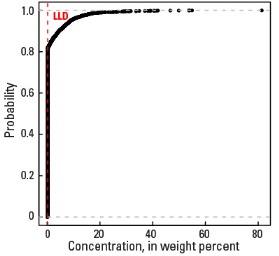
The purpose of these interpretive discussions is to provide a perspective on regional- and national-scale variations in element and mineral distributions in soils and their likely causes. The significant spatial variations shown by most elements and minerals can commonly be attributed to geologic sources in underlying parent materials, but other spatial variations seem clearly related to additional factors such as climate, the age of soils, transported source material, and anthropogenic influences. We attempt to distinguish the influence of these various factors on a regional and national scale. Numerous more local features might similarly be related to these same factors, but these features also have some probability of being an artifact of a random sampling of variable compositions, so that there is some probability of samples with similar compositions occurring in clusters of two or more adjacent sites by chance. Distinguishing such random occurrences from true variability is beyond the scope of the data from which these maps are constructed. Some caution, therefore, is advisable in interpreting the significance of these more local features unless some unique sources or processes can clearly be related to them.
Dolomite (Ca,Mg(CO3)2) is a calcium (Ca) and magnesium (Mg) carbonate (CO3) mineral; sedimentary carbonate rocks composed predominantly of the mineral dolomite are also called dolomite or dolostone. Most dolostone originally was deposited in the ocean as limestone and then altered to dolostone by Mg–rich seawater. Less commonly, primary dolomite can precipitate in playa muds and salt flats. Soils that develop on sedimentary carbonate rocks can typically inherit calcite, dolomite, or mixtures of both minerals from soil parent materials.
The distribution of mineral resource deposits with dolomite as a commodity (major or minor) in the United States, extracted from the U.S. Geological Survey (USGS) Mineral Resource Data System (MRDS) website, can be seen by hovering the mouse here. Statistics and information on the worldwide supply of, demand for, and flow of dimension stone (including dolomite) are available through the USGS National Minerals Information Center (NMIC) website.
In our data, the concentration of dolomite in the soil C horizon ranges from less than the detection limit of 0.2 weight percent (wt. %) to 81.4 wt. %, with concentrations in more than 80 percent of all samples below the detection limit. The concentration of dolomite in the soil A horizon ranges from less than the detection limit to 57.2 wt. %, with concentrations in nearly 90 percent of all samples below the detection limit (see the summary statistics [open in new window]). All samples with concentrations below the detection limit are grouped together in a single class for color coding the mineral concentration in the interpolated maps. Thus, the map for dolomite in the soil C horizon has eight classes, whereas the map for dolomite in the soil A horizon has six classes.
Dolomite is present in soils in the Great Lakes region, where glacial materials derived from sedimentary carbonate rocks were distributed in the down–ice direction by glaciers. In the Upper Midwest, melting of glacial ice following late Wisconsinan period advances (16,000 to 12,000 years ago) left the region north of the southern glacial limit (Soller and others, 2012) mantled with a blanket of mixed, immature sediments, from which present–day soils developed. Individual ice lobes (Grimley, 2000) created distinct patterns in soil mineralogy and geochemistry because of varying provenance and ice transport paths. 'Gray' (carbonate– and shale–rich) till in the James and Des Moines lobes (Grimley, 2000) was derived from Cretaceous sedimentary rocks (dolostone, limestone, and shale); glacial lake clays in the Red River Valley of the North (USDA, 2006) along the North Dakota–Minnesota border also contain dolomite in some areas. Gray tills were transported substantial distances to the south and southeast from their source and deposited in areas underlain by Precambrian bedrock. 'Red' quartz– and feldspar–rich till deposited in northeastern Minnesota, northern Wisconsin, and northwestern Michigan have a Precambrian crystalline rock provenance (Rainy lobe (Grimley, 2000)) and Precambrian red sandstone (with variable quantities of quartz and feldspar) provenance (Superior lobe (Grimley, 2000)), with no material derived from carbonate bedrock. Soils in eastern Wisconsin, northern Illinois, and northern Indiana developed on carbonate– and shale–bearing till sourced from sedimentary bedrock. Soils in this area have generally higher dolomite concentrations than soils in the 'gray' till areas of western Minnesota, North Dakota, and South Dakota. Distinct boundaries in the soil C horizon map along the southern glacial limit (Soller and others, 2012) and between 'gray' and 'red' till clearly separate soils containing dolomite from soils with no detectable dolomite.
In the western United States, notably sites in California, Nevada, Utah, Arizona, and Montana, soils containing dolomite formed on marine sedimentary carbonate rocks or on alluvium derived from similar bedrock. In parts of the eastern United States, where dolostone is the dominant bedrock, intense weathering of these old soils has removed all dolomite from the soil profile.
Secondary carbonates can accumulate in soils following initial dissolution of carbonate rocks; however, the formation of secondary dolomite in soils is rarely reported. Thus, differences in the concentration of dolomite at individual sites between the soil A and soil C horizons are mainly the result of leaching of dolomite from upper soils rather than addition of dolomite to deeper soils.
Statistics - 0 TO 5 CM
Statistics - A Horizon
| Number of samples | 4,802 |
| LLD | 0.2 wt. % |
| Number below LLD | 4,317 |
| Minimum | <0.2 wt. % |
| 5 percentile | <0.2 wt. % |
| 25 percentile | <0.2 wt. % |
| 50 percentile | <0.2 wt. % |
| 75 percentile | <0.2 wt. % |
| 95 percentile | 2.6 wt. % |
| Maximum | 57.2 wt. % |
| MAD | |
| Robust CV |
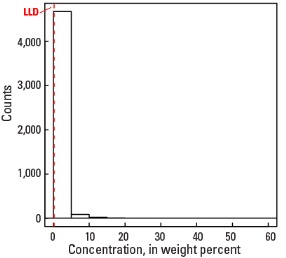
Histogram
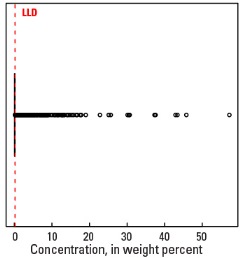
Boxplot
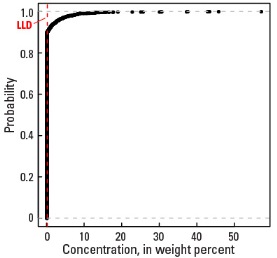
Empirical cumulative distribution function
Statistics - C Horizon
| Number of samples | 4,773 |
| LLD | 0.2 wt. % |
| Number below LLD | 3,902 |
| Minimum | <0.2 wt. % |
| 5 percentile | <0.2 wt. % |
| 25 percentile | <0.2 wt. % |
| 50 percentile | <0.2 wt. % |
| 75 percentile | <0.2 wt. % |
| 95 percentile | 8.9 wt. % |
| Maximum | 81.4 wt. % |
| MAD | |
| Robust CV |
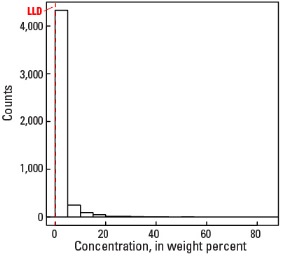
Histogram
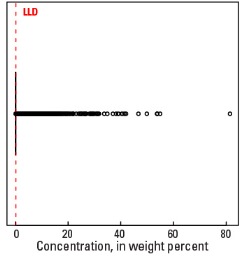
Boxplot
